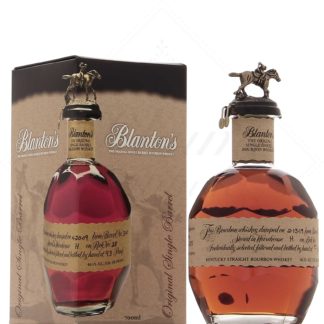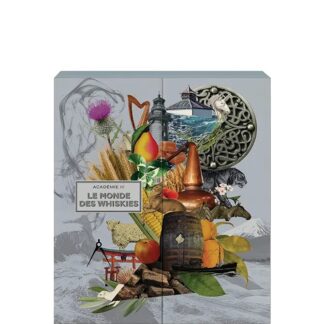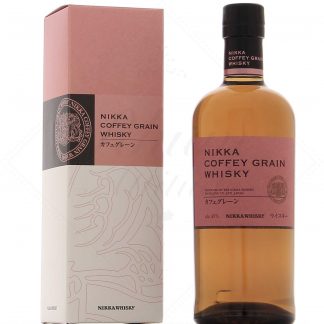Whisky
Whisky is one of the world's leading spirits. In fact, France is one of the world's biggest whisky consumers. Yet we don't always know exactly what's behind the term. Here are a few basic facts about this grain-based spirit.
Whisky: definitions and main families
Let's start with the raw material. It must be cereal, but it can be anything. Barley is the most common, but rye, corn and wheat are also used.
Furthermore, in all countries defining "whisky", it must be at least 40% proof and have matured for at least 3 years in oak casks.
If the product is younger, we generally speak of new make.
Last but not least, we'd like to mention the various appellations that can be found on the labels.
Malt whisky is produced from a single grain, malted and generally distilled in an iron still. Grain whisky, on the other hand, is made from a blend of cereals and is generally distilled in a column still.
Going a step further, we can cite the term single malt, which indicates that the whisky comes from a single distillery, and blended malt (formerly pure and vatted malt), which blends malt whiskies from different distilleries. Similar terminology applies to grain whisky.
Finally, when we speak of a blend, it indicates that malt and grain whiskies have been assembled.
Uisge beatha, whisky & whiskey: a Scottish and Irish heritage
Before it was called whisky, its common name was uisge beatha (brandy). It was first used by monks for curative purposes, before technical progress made it possible to produce it for gustatory purposes.
Later, it was in Ireland and Scotland that the spirit developed. And so, for centuries, these two nations have laid claim to its paternity.
Indeed, various war stories mention whiskey consumption by soldiers in Ireland, including Bushmills in the late 12th century.
The evidence put forward by the Scots does not come from testimony, but from written proof. An accountant's note fromLindores Abbey records the receipt of malt to make brandy.
Be that as it may, these two nations hold the roots of whisky and quickly made it a national symbol, accompanying the daily lives of their inhabitants, at deaths, births and weddings for example.
The term whiskey is generally used for Irish whiskies. This specificity stems from the 19th century, when the Irish wanted to differentiate themselves from their Scottish neighbors. By extension, we speak ofAmerican whiskey, while all other producing countries use the term whisky.
Worldwide whisky: Scotland, Ireland, USA, Japan and many others
Today, geographical barriers have been broken. Taking advantage of technological advances and the advent of malting plants that can supply grain to the four corners of the globe, new whisky countries are emerging.
We're thinking, of course, of the famous Scotch whisky from Scotland, the smoothness of Irish whiskey, American bourbons and ryes, but also Japanese whisky, recently considered the "best whisky in the world" and whose success continues to grow.
And yet, many nations are beginning to make their mark. These include France, of course, but also Taiwan,India, Sweden, the Netherlands, Switzerland andSouth Africa...
More than ever, whisky has gone global, although the historic players are still the most represented and sought-after.
Whisky making: from malting to distillation
While each distillery carefully guards its own particularities, from the choice of barley to the shape and size of its stills, there are a few key stages in the production process.
The first of these is malting. Although malting is rarely carried out at the distillery these days, it remains the most important process. When the grain (usually barley) is harvested, it lies dormant and needs to be awakened. To this end, a soaking phase is carried out. The barley is then spread on the soil, and germination continues. When the sprouts reach a few millimeters, the barley is called green malt. Germination is then stopped by drying the malt. To do this, the malt is placed in a kiln before being heated.
It's at this stage that peat, the emblematic element of the whisky world, can be used. It will deliver its fragrances when the malt is dried, via molecules called phenols. Peat levels are measured in ppm (parts per million) of phenol.
Peat comes from the partial decomposition of plants (heather, moss, etc.) and forms a blackish material which, despite its high moisture content, is used as fuel. Today, it is used only to impart specific aromas to cereals.
The malt is then ground. The malt, stripped of its impurities, is then transformed into a flour called grist. A grist mill is used here to complete this stage.
Next comes the brewing stage. Water plays an important role here, as it is the main element (about four times as much as grist). It takes place in a generally closed tank, called a mash tun, with rotating paddles.
This process produces a wort containing soluble starch, the sugar source needed to produce alcohol. The wort is collected in a vat called an underback.
Fermentation then takes place in vats known as washbacks. Originally made of wood, these are now often made of stainless steel. Once the vat is partially filled, yeast is added. Once the malt enzymes (amylases) have transformed the starch into fermentable sugars (maltose), the yeast transforms these into alcohol.
The result is a malt beer (6 to 8%), the wash, which is stored in wash-chargers.
The next logical step is distillation. This is a double distillation inpot stills.
The first stage takes place in large wash stills, and produces a liquid (low wines) of around 25/30% alcohol content, which flows through a spirit safe.
The second stage takes place in smaller stills known as spirit stills. This is where the final distillate, the new make, is produced. To achieve this, the master distiller makes cuts to isolate different parts of the liquid. The lightest elements form theheads, the middle cut is the part selected by the master distiller, while the heaviest elements form the tails.
In some cases, a third (or more) distillation is required. Grain whisky is distilled continuously, using column stills. Column stills were invented in the 1820s and 1830s to produce less expensive whiskies (patent stills and coffey stills), and contributed to the birth of blends.
Whisky making: maturing, bottling and blending
Once the new make has been recovered, it is transferred to oak casks for ageing. Maturation is probably the stage that has the greatest impact on the whisky's profile, and it is followed with the utmost attention by the cellar master.
The casks are then stored in warehouses for several years. It is during this phase that the famous "angels' share" takes place, i.e. the evaporation of the alcohol present in the cask (around 2% per year in Scotland, compared with 8% for rum in the tropics!)
Once maturity has been reached, the liquid is ready to be bottled. A distinction is made betweencask strength whiskies, which are bottled at their natural strength, and reduced strength whiskies, which have had water added.
In the latter case, another term often used isun-chillfiltered. The addition of water makes the liquid cloudy, and the fats that carry the aromas precipitate out.
So the liquid is passed through cellulose plates, which trap the fats. The fact that this is not done cold means that less fats are captured, and the aromas are better preserved.
Then there are the single casks, i.e. a limited edition from a single cask.
The final important point concerns blends. We've already mentioned the differences between blended malt, blended grain and blend, but there's also vatting. Since 1853, it has been possible to blend different casks within the same distillery. This is also the case for most bottlings from distilleries that call on the skills of their masterblender.
Note that when blending whiskies of different ages, the youngest should be mentioned.
Finally, the term " small batch " is sometimes used to indicate that a blend has been made from just a few casks.
Official and independent bottlings: a wide choice
Another distinction can be made among the many bottles on offer.
Official bottlings are those produced by the distilleries themselves. The aim is generally to create a coherent range with a fairly homogenous identity. In addition, there are independent (or merchant) bottlings, which are casks selected for their uniqueness and personality.
From the 1960s onwards, distillery brands took off on the world market(Glenfiddich was a pioneer).
As far as independent bottlers are concerned, while the first traders such as Berry Bros & Rudd, Cadenhead and Gordon & Macphailgo back a long way, they really came into their own in the 1990s. Read less
-
Loch Lomond 2011 Brut de cask #4950 11 years old Rum Attitude selection 56.5°
- Scotland
- 56.5 ° - 70 cl
-
-
-
-
-
-
-
-
Weller 12 year old The Original Wheated Bourbon 45°, The Original Wheated Bourbon
- United States
- 45 ° - 70 cl
-
Bellevoye Vert Whisky de France Triple Malt Calvados Finish 43° (43° proof)
- Mainland France
- 43 ° - 70 cl
1 notice -
-
-
-
-
-















